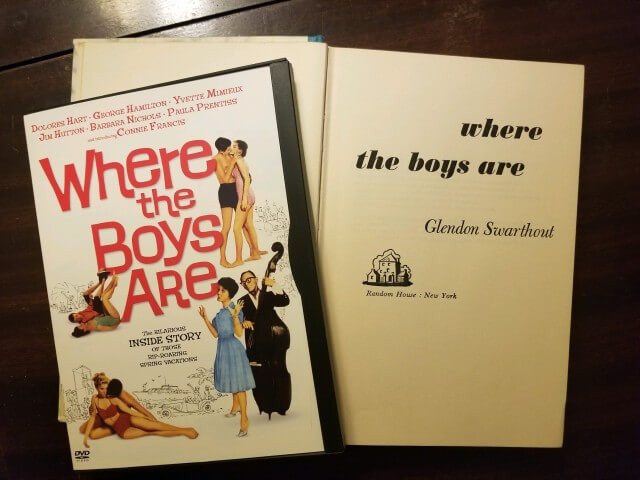Last Updated on September 23, 2022
by Authentic Florida Book Reviewer, Joyce Sparrow
Where the Boys Are, written by Glendon Swarthout (1918-1992), and published in 1960, takes readers to Fort Lauderdale in March 1958, where Ivy League boys go to meet mid-western girls. The novel is written from the point of view of 18 year old Michigan State freshman Merrit, who drives 36 hours straight with her friend, Tuggle, to escape cold, snow, ice, parents, and the professors who are forcing Merrit to declare an academic major before the end of the term. The girls are staying in an apartment for $10 a night, a little out of their budget, but across the street from the beach.
The plot involves Merrit and Tuggle’s carrying out their plans to get tans and meet boys. TV Thompson is the first boy who stumbles across the girls. TV wears a pith helmet and sunglasses and carries a white cane for the blind as a way to stand out in the crowd. TV is a self-invented entrepreneur who devises schemes to earn his tuition. His latest money-maker is conducting personality tests for graduating students. TV is a deep thinker who comments years before Mr. Disney opens his world in central Florida, that he believes in Walt Disney, not God, because kids have more contact with Walt Disney through television than they have with church.
Swarthout based the novel on his own research when he traveled with students from Michigan State to Fort Lauderdale for spring break. Readers may be surprised to learn the novel captures considerable current events from 1958 that are similar to what is found in today’s news headlines including Cuba, teenage anguish, and the value of a college education.
The movie version of Where the Boys Are was also released in 1960. The cast includes Connie Francis, George Hamilton, Jim Hutton, and Frank Gorshin. The film won awards for Best Comedy of the Year and Best Comedy Actress for Paula Prentiss. The screenplay, written by George Wells, focuses on romance.
By comparison, the novel is less a romantic comedy and more a commentary on the demands on college students who live in over-crowded dorms and experience constant pressure to meet academic standards. There is a great deal of discussion among the characters about finding jobs, working hard, and earning money so they can return to Florida in 20 or 30 years to have less fun than they are having in 1958. So, as in much of Florida fiction, the dream of living in Florida remains.
Readers see Florida through the eyes of Merrit and Tuggle.
When Merrit suggests to Tuggle that dating a different boy every night makes them promiscuous, Tuggle responds: “It’s the tropics! You simply go to hell in the tropics.”
While having cocktails at what Merrit describes as a “corny” club where they watch “fat tourists dancing like bears” Merrit remembers that her friend Basil said that the students would all “kill themselves to return to Lauderdale in twenty years for this.”
As Merrit is discussing the outlook of job security with Ryder who is deciding whether or not to join his uncle’s hydraulic system coupling firm after graduation, she loses her train of thought and wonders what day of the week it is. “In Florida time is a blender in which you pour your kids and ice and experience and a bunch of other mystic ingredients and whrrrrr!”
At the end of her spring break experience, Merrit concludes that love is “little more than a tourist attraction in Lauderdale.” She contemplates the $115 she spent on the trip, without making a decision about an academic major. Merrit concludes that life is not about choosing what she wants to be, but who she wants to be.
The biggest surprise in the novel is the role of Cuba. Merrit, Tuggle and their new found friends decide to make an impact when visiting Miami and raise money for Cuban families. The novel contains details about Miami’s Cuban population who funnel money to bring their relatives to Florida.
In many ways, Where the Boys Are is timeless. Students continue to travel to Florida for spring break, spent time on the beach and money in the bars. The classic suit, tie and party dress attire required in clubs in the 1950s, however, is long gone. The students come for a week to escape the cold, their parents, and academic pressures. Looking for love is still, possibly, a tourist attraction. Do they dream of returning in 20 or 30 years after a successful career? Most likely. Or, at least, they dream about one trip to Disney World with their children.
Joyce Sparrow writes “Florida Reads” the book review column for the Florida Library Association’s publication, Florida Libraries. She also publishes book reviews in Library Journal. Contact Joyce at [email protected]
In accordance with FTC guidelines regarding endorsements and testimonials, the books reviewed on the Authentic Florida site are provided for free by the guest contributor. Authentic Florida does not receive money for the reviews.

